Udon with no Shoes On
Before the holidays, I was browsing in the bookstore that is attached to Uwajamiya, one of Seattle’s large Asian food grocery stores. I was there to find some manga as a present for my daughter, but of course, immediately got sucked into the cookbook section, completely tempted by book after book that I had never seen before. Never mind that they were written in kanji, so I had no hope of reading any of them…. the photos were enough to keep me mesmerized until realizing the time, I had to rush on over to get the books I was supposed to be buying.
Afterward, one set of books stuck with me… those by Harumi Kurihara. The Japanese versions of these books are graphically gorgeous, light, airy and elegant. I knew I’d have to find the English version. Luckily, there are two… not quite in the same light style, but still beautifully published. Last week, I picked up Harumi’s Japanese Home Cooking and flipping through I knew I had a winner of a book. Many of my favorite Japanese dishes… tonkatsu, gyoza, tomago are beautifully illustrated. Finding the recipe for homemade udon noodles, however, was the real kicker.
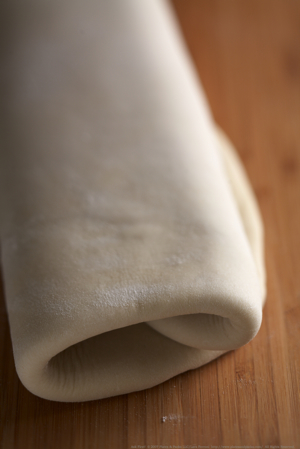
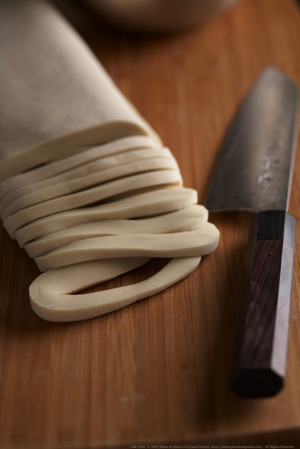
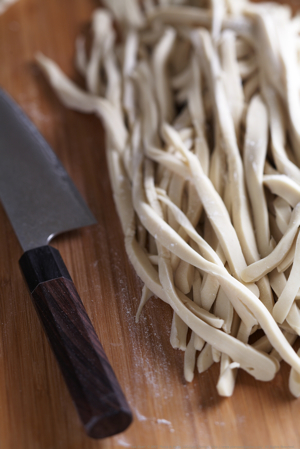
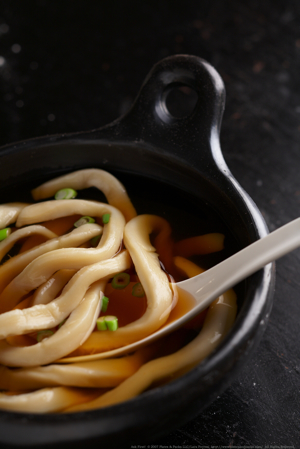
Even better, these noodles are about the most fun thing to make (not to mention incredibly simple). I thought I’d be able to use my new toy… the pasta attachment for my Kitchen Aid…but as it turns out, these slippery, thick noodles really don’t require anything other than a bit of arm strength and some time. In fact, I highly recommend against using the dough hook attachment on the Kitchen Aid for the initial kneading… I gave it a try, and found that it couldn’t get the dough to form into a ball well enough when my hands could. Once the dough was in a ball, it was far too heavy and stiff for the mixer to knead it properly. That said, it’s also too hard to knead it with your hands at that point… so Harumi has a wonderful solution. Use your whole body… by wrapping the dough in a plastic and then a towel, you walk all over it to help work the gluten in the dough. Brilliant! It’s so much fun. If you have kids, you must give this a try. Or, even if you don’t.
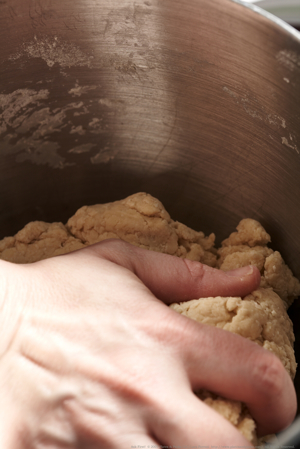

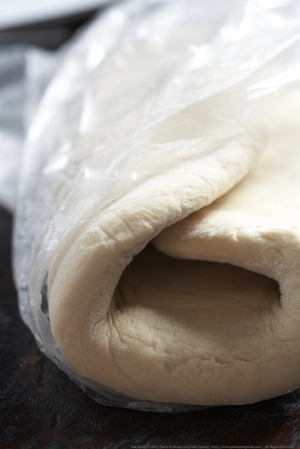
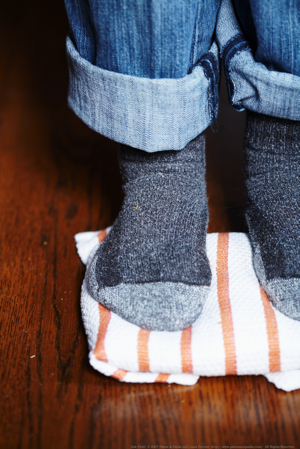
I found the noodles this recipe makes to be more on the rustic side… more like handshaven noodles than packaged udon. That’s part of what makes them good… but if you prefer a more even, refined noodle, and you have a pasta maker, try using the roller to press out the dough before hand cutting the noodles.
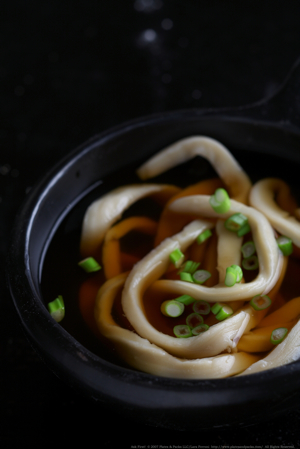
Udon
1 cup lukewarm water
5 t salt
3 1/2 c bread flour
1 1/2 c all-purpose flour
Dissolve the salt in about 1 T of the water, then add the rest of the water. Set aside.
In a very large bowl that you’ll be able to knead the dough in, combine the two flours with a fork. Make a little well in the center, and add the salted water. Use the fork to pull a little bit of flour into the liquid, and then start to use your hands to work the moistened flour into the rest of the flour. Depending on the moisture content of your flour, you might need to add a bit more water… as the dough comes together, it should form into a lumpy ball. If it stays as too ragged, sprinkle a bit more water on and work it in.
Start seriously kneading the dough as hard as you can for about 10 minutes, on a board dusted with bread flour. If the dough is too sticky, knead in a touch more of the bread flour. To knead, fold over from the top, and use the heal of your palm to press it flat again. Turn the dough 45 degrees and repeat.
Now comes the fun part. Wrap the dough in a heavy duty plastic bag. I like to use left over produce bags.. but they are thin so I double wrapped to be safe. Then, wrap the the plastic bag in a largish kitchen towel. Set it on the ground and stand on it. Move around, do a little dance, hop up and down, take a stroll. Your whole body weight on the dough will work it like your hands never could. This helps make the noodles good and chewy. After a few minutes, take the dough out of the bags… it will be pretty flat, but with a rolling pin, roll out any irregularities. Then give it a fold, put it back in the bag, wrap it in the towel and walk on it some more. Repeat this process about 4 times. Then, leaving the dough in the bag, let it rest for 3 hours in a warm place.
After it’s had a chance to rest, take the dough out and form it into a ball. Place it back in the bag & towel and walk on it one more time… this time making a point to try to spread the dough as much as possible. The thinner you can get it by walking on it, the easier the rest of the process will be.
Take the dough out from the bag again, and roll it out on a floured surface until it is a square about 1/8 inch thick. The dough may be pretty stiff and springy, so this may be a bit challenging. If you can’t seem to get it thin enough with a rolling pin or if you want a more refined udon, cut it into 4 pieces and run it through the thickest setting of a pasta machine, and give them a good dusting of flour.
Next, fold the dough from the top to the center and then from the center to the bottom (like an accordian). Then, with one of the long edges facing you, slice off the dough in 1/8 inch pieces. Dust the sliced pieces with a bit more flour as you go to prevent them from sticking.
Boil the noodles immediately, or cover with a towel while you are waiting for the water to come to a boil. The noodles will need to boil for about 7 minutes, stirred with a chopstick to prevent them form sticking together.
Traditionally, the noodles are served hot, with a dashi-based stock. But, they are also delicious stir fried with a splash of sesame oil, oyster sauce, soy, sesame seeds and some veggies or meat of your choice.
very nice. i’d love to make my own udon. you make it look so easy 😉
I love of the no shoes dough kneading technique! The rustic looking udon looks delicious!
Ooh, this will be a fun weekend project. Can’t wait to “dance” on the dough!
Walking on noodles, you’re so clever! I would have just been extremely frustrated with the dough and had tough noodles.
This is great timing, Lara. Iris and I were talking about making kitsune udon next week, and now we’ll totally make our own noodles for it. Let me know if you try anything else in the Harumi book; I have a hold on it at the library.
Cool, your own Udon. Since my hubby no longer works in the ID I dont get down to Uwa anymore.
Wow! Your very own udon. My husband who grew up in Japan would think this was so cool. And my kids would get a kick out of helping. I’ve *GOT* to try these. Do you know how impressed my mother-in-law who lives in Japan would be? She’s not Japnese, but she’d think this was so cool!
The Harumi book is great, I have had it for about 4 months now, and cooked quite a bit from it – the sesame miso is fantastic. Pounding up the sesame seeds is amazingly aromatic. This was certainly one of my favorite cookbook purchases of last year. I keep meaning to cook more and more from it actually.
Out of interest, where did you get those great little cast iron dishes you have there?
Lara, Thank you so much for the recipe. I love udon noodles, and I buy ’em frozen from Asian stores. The frozen ones are softer but starchier than dried ones, which makes ’em perfect in soups. I don’t have a kitchen aid mixer, and am all for mixing by hand (and legs). For someone who makes roti every week, this should be lot of fun.
Thank you Linda, Chuck & Mandy!
Brilynn – Thanks, but I can’t take credit for the idea… it came from the Harumi cookbooks… even with a cool photo of her standing on the dough. I couldn’t resist!
Matthew – I did make the tonkatsu recipe the same night, and it worked out beautifully…although I did a double dip of egg/panko because the first layer seemed to thin, and I think that was the right thing to do, because the resulting cutlets were perfect.
Peabody – I don’t make it down there nearly as much as I should…although there are also lot of other shops in the ID, esp around 12th & Jackson worth going to as well.
Thanks Amy!
Matt – The black bowls are actually some kind of clay, not cast iron. And I got them at Crate & Barrel of all places. But they were on sale, and the only thing they seem to have last is this one: http://www.crateandbarrel.com/family.aspx?c=385&f=25116&q=chamba&fromLocation=Search&DIMID=400001&SearchPage=1
I have seen the Chamba ware at other stores though,so you can probably find them around. You might try City Kitchens downtown.
Suganya – You are very welcome! Have fun!
your udon looks great! it seems like a fun way to workout before a fulfilling dinner! =D i’ve tried making noodles or ban mian from leftover gyoza dough but they weren’t as springy as i’d like them to be. now i know why!
i’m looking forward to more japanese dishes on your blog now that you have your japanese cookbooks!
Dear Lara – your beautiful images reminded me of my ‘ashifumi’ udon making many years ago – I love noodles and your udon looks lovely! Maybe you will try making your own dashi next time…? You know Harumi is like a Japanese version of Martha/Delia but there are many other great writers too, I’ll try to find some books for you and let you know 🙂
You know, just when I think I am fully used to the gorgeus work you do, these photos stopped me in my tracks — especially the shots in the black bowls, and the first knife image. Wow.
I love Harumi’s cooking. She is very famous in Japan (that’s what my Japanese hairdresser told me!) I have got a copy of her book and I love all the recipes as they are really easy to make and very tasty! I just recently made Chawan Mushi with different ingredients that she suggested and turn out really yummy!
I love Udon… all the noodles like shoba and ramen too!!
Nice pictures!! love them!
Aah – that technique of kneading dough is familiar. An regional Indian fried snack (called Mathia) has a dough that is incredibly hard to knead as well, and we used this shortcut on it..
so impressive! after reading ruth reichl rave about perfect udon in garlic & sapphires, i’ve been curious and intimidated about these noodles! how incredible that you made them yourself!
Your pictures are wonderful!
My grany used to seat on her varenikies -Rusian dumplings dough. This is too funny.
What beautiful photos! Rustic homemade noodles are my favorite too. Can’t wait to give this a try.
this reminds me of the movie IRMO (maybe it’s ERMO). A chinese movie about a woman who goes from the countryside to sell her noodles in the city to make enough money to get a TV to show up her neighbor, the mayor’s wife. She makes so many noodles each day, that she uses a huge bowl with a wooden post next to it to lean on while she stands in the bowl and mixes the dough with her bare feet.
fantastic photography, fantastic recipe. i’ve already gone to the link to order the book.
k
I’ve never thought of making my own udon – perhaps because I love them so much and don’t want to disappoint myself – but you make it seem possible for even mortals like me to tackle it.
Wow! That is some THICK udon!
Looks great!
I actually had the opportunity to attend a soba uchi (soba making) ‘party’ the other day in Kyoto. Some of the people in this group have been making soba twice a month for about 10 years, and they make some excellent soba! I am going to go again and take some piks to put up on my site.
I have never made udon, but I am sure it is tough! Good going! Love the ingenious use of feet for want of a udon rolling pin!
Peko@KyotoFoodie
The past six months I’ve nourished a growing obsession with udon. The only other recipe for homemade udon I’ve looked at (in an issue of Saveur several months ago) involved some kind of special flour, and thus I’ve delayed in trying it out. I’m glad to see it’s not a prerequisite for homemade chewy noodle goodness.
Nice socks, by the way. Thorlo, no? I have some meself 🙂
I love Udon noodles, I’ll defintely have to make some! I just added the book to my list of books to check out at the library. Thanks!
Yum – what a delicious project!
What great photos – you just gave me a whole new appreciation for udon noodles.
Iris and I made this today and it was great fun. I have a couple of tips to offer.
First, a two-gallon Ziploc bag worked perfectly for the foot-stomping part. We happened to have a box of these on hand and I was glad we did.
Second, if you make the noodles and aren’t ready to eat them right away, don’t do what I did and stick them in a bag in the fridge, where they did their best to congeal back into a ball of dough. Instead, do what they do at the udon factory: parboil them for a minute or two, drain, and toss them with oil, then refrigerate. You could never get away with this with spaghetti, but the udon is so thick and hardy, it’s not going to get mushy.
We used the noodles to make kitsune udon, with chicken and fried tofu, and I thought it was great despite the fact that our beautiful noodles ended up more like spatzle.
I’ve got 2 of Harumi’s books, and love them both (even if I haven’t cooked much from them). The udon ‘technique’ looks like loads of fun, so thank you so much for highlighting the recipe. I’ll go and browse through the books tonight!
i love the rustic noodles! who wants perfect noodles when you have handcut and massaged noodles?
I love these noodles too!
That is just so cool! I really want to try it, and I like that you don’t have to have any fancy equipment.
This recipes looks like great fun. I love Udon noodles. Will definetly have to give this one a go.
Just made some! Thanks for the inspiration!
Just made chicken soup, but I really wished I had made this noodle soup. I think I will give it a try next weekend.
I just “Stumbled” upon your blog– this looks so easy and fun. I am going to try tomorrow. Thank you for posting it. Also, your photographs are so crisp and beautiful.
Thanks for doing this. I made the recipe (http://feedingmaybelle.blogspot.com/2008/02/chicken-soup-again.html ), though perhaps not in as lovely a manner as you. And, more importantly it has sparked me to think about making cha soba by hand.
okay, i just gasped out loud a little when i saw this recipe. i *heart* udon.
next time i have a tense day at work and need to let off some steam, i’m making udon.
— Us vs. Food
I made an impromptu stirfry, but it was really salty. I think I’ll cut some of the salt out of the dough, and see how it tastes, otherwise it was great!
Ohhhhhh, this looks amazing.
These look so good, especially with the knife-cutting technique. Koreans have a noodle they call, “kahl gook-soo,” literally translated, “knife noodles.” The rustic quality turns them into pure comfort food.
I’m planning on making these for 5 people this coming weekend. Could you tell me how many people this recipe can feed? I’m counting on seconds, or even thirds. 🙂 Thanks! I love your blog!
Hi again I made a 1/2 recipe of the noodles with a friend and we put them in soup… it was amazing. We even wrote down the recipe. ^_^ My grammy wants to make them with me sometime soon. I’m looking forward to it!
Funny how I have had the internet for years, been trying to make Japanese/ Chinese dishes for years, but never thought about looking on-line. My obsession with Udon noodles came about through my obsession with trying to make the best Lo-Mein noodles that I could. As soon as I learned how to make Lo-Mein, I found out about Udon and somehow forgot about any other noodles. These noodles (Udon) are so easy to make, that I may never buy pre-made noodles again. I recommend that everybody interested try making Udon!
I’ve never even thought about making my own udon but now seeing yours, it makes me want to! What beautiful noodles and dough.
These noodles look amazing! I can’t wait to try it myself. I love that you don’t need a pasta machine or anything. Thank you for posting this great looking recipe!
I’m so glad you pointed out this post to me. Happy noodle day!
Wow, these photos are so beautiful. I just discovered your blog and am very impressed by the presentation. I have been studying this recipe for a few days and finally got up the courage to try it, so I bought bread flour today and will put them together tomorrow afternoon with my sister. The cookbook that you used also looks excellent, and I am hoping that I can get my hands on a copy soon.
Best,
Ai Lu
I am looking for an old fashion hand crank udon noodle roller. please email if you have any idea where to find one.
Thanks,
Anne
please make the photos available
Oh my goodness. It’s that easy? I have loved udon forever- spent time in Japan many yrs ago (and your mention of Uwajimaya makes me nostalgic…I used to live in Seattle and LOVE that store). Must try this!